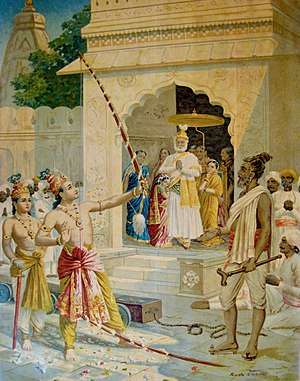Pinaka (Hinduism)
Shiva Dhanush (Sanskrit: शिव धनुष) or Pinaka (Sanskrit: पिनाक, pínāka) is the bow of Lord Shiva.[1]
| KODHANDAM | |
|---|---|
 Rama breaking Shiva's Dhanush (bow) to win Sita as wife | |
| Type | Bow |
| Service history | |
| Used by | Shiva |
Background
Vijaya is the original bow of Shiva used for total destruction or "Pralaya".
Legend
As per original Valmiki Ramayana, two bows were created by God Devendra of equal capacity which were given to Rudra and Vishnu and requested them to fight with each other to know who is the powerful one. However just before the start of the war an Aakashvani said that the war will lead to total destruction and hence the war was stopped. On hearing Aakashvani, Rudra threw his Dhanush which fell on earth to be later known as "Shiva dhanush". It was later found by King Devaratha, the ancestor of King Janaka. It is mentioned in the Hindu epic Ramayana, when its hero Rama (another avatar of Vishnu) breaks it to marry Janaka's daughter as his wife.
Vishwakarma crafted two divine bows. He gave Sharanga to Lord Vishnu and Pinaka to Lord Shiva. King Janaka of Mithila had a daughter named Sita. In earlier part of her life, Sita while playing with her sisters had unknowingly lifted the table over which the bow had been placed; which was something no one in the kingdom could do. This incident was however observed by Janaka and he decided to make this incident as the backdrop for Sita's swayamvara.
Later, Janaka had announced that whosoever wanted to marry Sita had to lift the divine bow and string it. The bow was broken by Ayodhya's prince Rama when he attempted to string the bow, during the swayamvara of Sita, thereby winning the princess's hand in marriage. After the marriage when his father Dasharatha was returning to Ayodhya with Rama, Parashurama obstructed their path and challenged Rama for breaking his guru Shiva's bow. Rama extolled the sage. After that Dasharatha prayed to the sage to forgive him but Parashurama remained enraged and brought out Vishnu's bow. He then asked Rama to string the bow and fight a duel with him. Rama snatches the bow of Vishnu, strings it, places an arrow and points it straight at the challenger's heart. Rama then asks Parashurama what he will give as a target to the arrow. At this point, Parashurama feels himself devoid of his mystical energy. He realizes that Rama is the avatar of Vishnu.
Another tale
Another tale of Pinaka revolves around the tale of Lord Vishnu fighting Lord Shiva, mentioned in Seventy fifth sarga of Bala kanda of Ramayana. Parashuram narrates this to Lord Rama before challenging him to string Sharanga. The story goes like this-The Devas wanted to test the superiority of Lord Vishnu and Lord Shiva and asked Lord Brahma to create a difference of opinion between them. In the battle that ensued, Lord Vishnu utters a battle cry "hum" which paralyzes the Devas and Lord Shiva. His bow is rendered useless, and Lord Vishnu's bow Sharanga prevails.[2][3][4] This Pinaka was broken later by Lord Rama as commonly said .But later in Dwapara yuga when Arjuna meets Shiva (Kirata Parva XXXIX )Arjun saw Lord Shiva wielding Pinaka with Parvati aside.
Vaisampayana continued, "Phalguna then beheld him Mahadeva that god of blazing splendour that wielder of Pinaka that one who had his abode on the mountains (of Kailasa) accompanied by Uma. Hence the one mentioned could be some other bow.
Rama also snatches Sharanga from Parashurama and gives it to Varuna, lord of the oceans, for safekeeping.
Other origins
Although reference is still to be inserted from Puranas (ancient Hindu texts) there is a connection of Pinaka with the life of Maharshi Dadhichi a sage who helped devas to defeat the asura Vritra and later on request gave up life and provided his bones for making a Vajra which Indra used to kill the Demon Vritrasura.
References
- Williams, Monier. "Monier-Williams Sanskrit-English Dictionary".
pínāka m. n. a staff or bow, (esp.) the staff or bow of Rudra-Śiva
- http://hinduism.stackexchange.com/questions/2219/why-did-lord-shiva-fight-with-lord-vishnu
- http://ramayanam-atwistedversion.blogspot.in/2012/12/32-legends-of-shiva-and-vishnu-bows.html
- http://redzambala.com/ramayana-valmiki/ramayana-bala-kanda-chapter-75.html